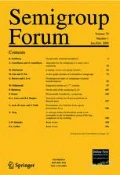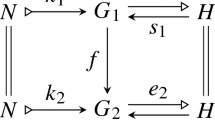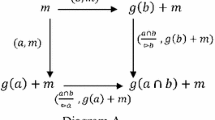Abstract
The interval monoid \(\Upsilon ({P})\) of a poset P is defined by generators [x, y], where \(x\le y\) in P, and relations \([x,x]=1\), \([x,z]=[x,y]\cdot [y,z]\) for \(x\le y\le z\). It embeds into its universal group \(\Upsilon ^{\pm }({P})\), the interval group of P, which is also the universal group of the homotopy groupoid of the chain complex of P. We prove the following results:
-
The monoid \(\Upsilon ({P})\) has finite left and right greatest common divisors of pairs (we say that it is a gcd-monoid) iff every principal ideal (resp., filter) of P is a join-semilattice (resp., a meet-semilattice).
-
For every group G, there is a connected poset P of height 2 such that \(\Upsilon ({P})\) is a gcd-monoid and G is a free factor of \(\Upsilon ^{\pm }({P})\) by a free group. Moreover, P can be taken to be finite iff G is finitely presented.
-
For every finite poset P, the monoid \(\Upsilon ({P})\) can be embedded into a free monoid.
-
Some of the results above, and many related ones, can be extended from interval monoids to the universal monoid \({\mathrm{U}_\mathrm{mon}}({S})\) of any category S. This enables us, in particular, to characterize the embeddability of \({\mathrm{U}_\mathrm{mon}}({S})\) into a group, by stating that it holds at the hom-set level. We thus obtain new easily verified sufficient conditions for embeddability of a monoid into a group.
We illustrate our results by various examples and counterexamples.


Similar content being viewed by others
References
Adjan, S.I.: Defining relations and algorithmic problems for groups and semigroups. Trudy Mat. Inst. Steklov. 85, 123 (1966)
Bergman, G.M.: On monoids, \(2\)-firs, and semifirs. Semigroup Forum 89(2), 293–335 (2014)
Brieskorn, E., Saito, K.: Artin-gruppen und Coxeter-gruppen. Invent. Math. 17, 245–271 (1972)
Dehornoy, P.: Complete positive group presentations. J. Algebra 268(1), 156–197 (2003)
Dehornoy, P.: Foundations of Garside Theory, EMS Tracts in Mathematics, vol. 22, European Mathematical Society (EMS), Zürich: with François Digne. Eddy Godelle, Daan Krammer and Jean Michel (2015)
Dehornoy, P.: Multifraction reduction I: the 3-Ore case and Artin-Tits groups of type FC. J. Comb. Algebra 1(2), 185–228 (2017)
Dehornoy, P., Dynnikov, I., Rolfsen, D., Wiest, B.: Why are Braids Orderable? Panoramas et Synthèses [Panoramas and Syntheses], vol. 14. Société Mathématique de France, Paris (2002)
Dehornoy, P., Wehrung, F.: Multifraction reduction III: the case of interval monoids. J. Comb. Algebra 1(4), 341–370 (2017)
Freyd, P.: Redei’s finiteness theorem for commutative semigroups. Proc. Am. Math. Soc. 19, 1003 (1968)
Garside, F.A.: The braid group and other groups. Q. J. Math. Oxford Ser. (2) 20, 235–254 (1969)
Higgins, P.J.: Notes on Categories and Groupoids, Van Nostrand Reinhold Co., London-New York-Melbourne, Van Nostrand Reinhold Mathematical Studies, No. 32 (1971)
Meakin, J.: Groups and semigroups: connections and contrasts, Groups St. Andrews: Vol. 2, London Math. Soc. Lecture Note Ser., vol. 340, Cambridge University Press, Cambridge 2007, 357–400 (2005)
Remmers, J.H.: On the geometry of semigroup presentations. Adv. Math. 36(3), 283–296 (1980)
Reynaud, E.: Algebraic fundamental group and simplicial complexes. J. Pure Appl. Algebra 177(2), 203–214 (2003)
Rota, G.-C.: On the foundations of combinatorial theory. I. Theory of Möbius functions. Z. Wahrscheinlichkeitstheorie und Verw. Gebiete 2, 340–368 (1964)
Rotman, J.J.: An Introduction to Algebraic Topology. Graduate Texts in Mathematics, vol. 119. Springer, New York (1988)
Rotman, J.J.: An Introduction to the Theory of Groups. Graduate Texts in Mathematics, vol. 148, 4th edn. Springer, New York (1995)
Spehner, J.-C.: Présentations et présentations simplifiables d’un monoïde simplifiable. Semigroup Forum 14(4), 295–329 (1977)
Spehner, J.-C.: Every finitely generated submonoid of a free monoid has a finite Mal\(^\prime \) cev’s presentation. J. Pure Appl. Algebra 58(3), 279–287 (1989)
Author information
Authors and Affiliations
Corresponding author
Additional information
Communicated by Markus Lohrey.
Rights and permissions
About this article
Cite this article
Wehrung, F. Gcd-monoids arising from homotopy groupoids. Semigroup Forum 97, 493–522 (2018). https://doi.org/10.1007/s00233-018-9950-5
Received:
Accepted:
Published:
Issue Date:
DOI: https://doi.org/10.1007/s00233-018-9950-5




